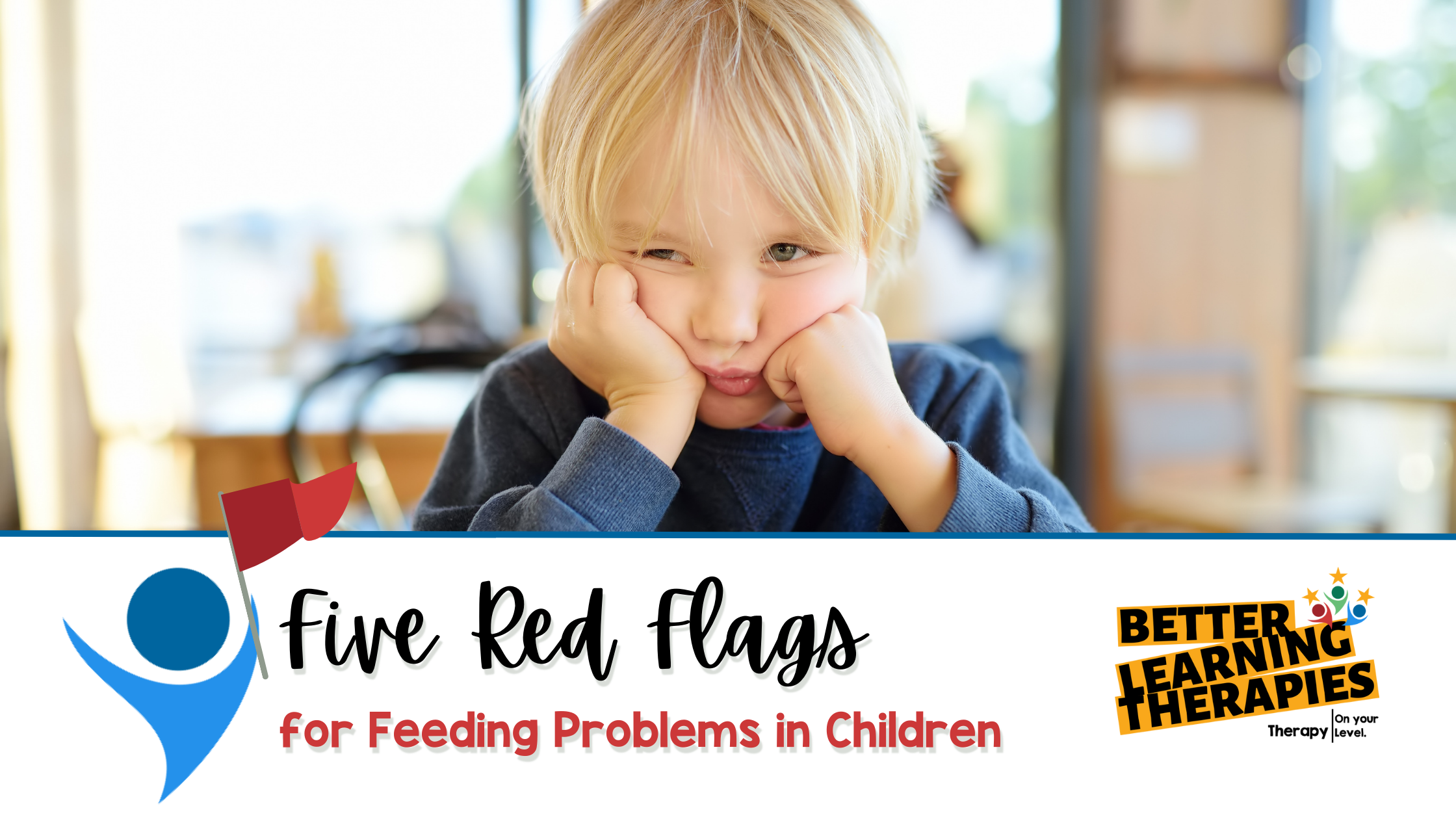Red Flags for Feeding and Swallowing Problems in Children
By Natalie Wetherwax, MS-CCC, SLP
Like potty training troubles, picky eating is a common occurrence in childhood. When a child doesn’t eat it can become distressing to parents, which is very understandable! How do you know if your child is going through a phase or if there is something else going on? Here are five red flags that might indicate your child needs the support of a feeding therapy professional.
The following is not a comprehensive list of possible red flags for feeding and swallowing issues in children. If you are concerned about feeding or swallowing problems, it is best to address concerns with your pediatrician or a specialist.
Five Red Flags
Red Flag # 1: Eating is never an enjoyable activity.
Infants and children should typically enjoy being fed/engaging in eating times, demonstrating interest in the caregiver feeding them, turning toward food sources, and having a calm body. If your child demonstrates signs of discomfort, disengagement, or pain, this could be a red flag for feeding concerns. At the same time, it should be an enjoyable and social experience for caregivers. If you find you have to beg, coerce, and bribe your child or mealtimes feel like a constant battle, this could be a red flag.
Red Flag # 2: Your child eats a limited number of foods.
Most children will eat a variety of foods that have different flavors and textures in all food groups (fruits, vegetables, cereals and bread, protein, dairy, etc). Naturally, children will enjoy some flavors more than others (prefer an apple to a carrot). If your child only eats 1-2 foods or gags or tantrums, when encountering new food or different textures, this is a red flag.
In addition, most children will attempt playing with (touching), tasting, or eating a familiar food (introduced about 10 times). If your child refuses to engage in any of these ways with familiar food, this could be a red flag.
Red Flag #3: Your child does not demonstrate hunger cues.
Children should generally let you know when they are hungry and when they are full. If your child never initiates eating/feeding by asking for food (this might look like pointing, leading you to the refrigerator, crying due to hunger, or obtaining food themselves), this could be a red flag. They should also let you know they are full by refusing food or discontinuing eating and showing signs they are content following meal times. If your child demonstrates disinterest in food or never appears satisfied following eating, this could be a red flag and should be addressed with her pediatrician.
Red Flag #4: Time spent eating (too little or too much).
Too much or too little time spent eating/feeding could be a red flag. If your child engages in feeding/eating tasks for less than 5 minutes or for more than 30 minutes, this could be a red flag. Children who take less than five minutes to eat may not be eating enough and children who take more than 30 minutes to eat could have difficulty with the oral motor aspects of eating and swallowing, become distracted easily, or have sensory issues related to food.
Red Flag #5: Your child coughs, gags, vomits, or appears to struggle while eating.
The following are red flags for difficulty with the oral motor movements and sequences needed to coordinate eating and swallowing:
Coughing or gagging on food or drink.
Difficulties coordinating breathing and swallowing.
Food often spills out of the mouth or nose.
Gurgly, hoarse, or breathy sounding voice when eating or drinking.
Vomiting during meal times.
Persistent or recurrent respiratory infections/pneumonia.
Difficulty gaining weight.
Seeking Help
If you think your child may need more professional support, looking for a feeding specialist is a great next step. There are many strategies you can use at home and because eating is such a complex task a professional can help make sure these areas are addressed and strengthened to support your child and family.
“The good news is that feeding therapy can help! The earlier you begin working with a feeding therapist, the faster you will see changes. It is much easier to change a 2-year-old’s relationship to food than a 12-year-old’s; however, feeding therapy can help make mealtimes more enjoyable for people of all ages! Adults can even benefit from these strategies.” (Red Flags - SOS Approach to Feeding)
Feeding Therapy at Better Learning Therapies
At Better Learning Therapies, we are proud of our interdisciplinary team! When you call us, we’ll set up an evaluation to assess your child's current feeding skills. We schedule feeding evaluations around your child's typical eating schedule and ask you to bring 3 of your child's preferred food items and 3 of your child's non-preferred food items to the clinic that day. The assessment will occur as a natural eating experience with you and your child. We will develop a specific feeding plan of care, any needed recommendations, and a treatment schedule for your child based on our observations in the assessment.
Most clients will benefit from an individualized 12-week program that can be repeated if needed to continue addressing feeding needs. Click Here to learn more about feeding therapy at BLT.







